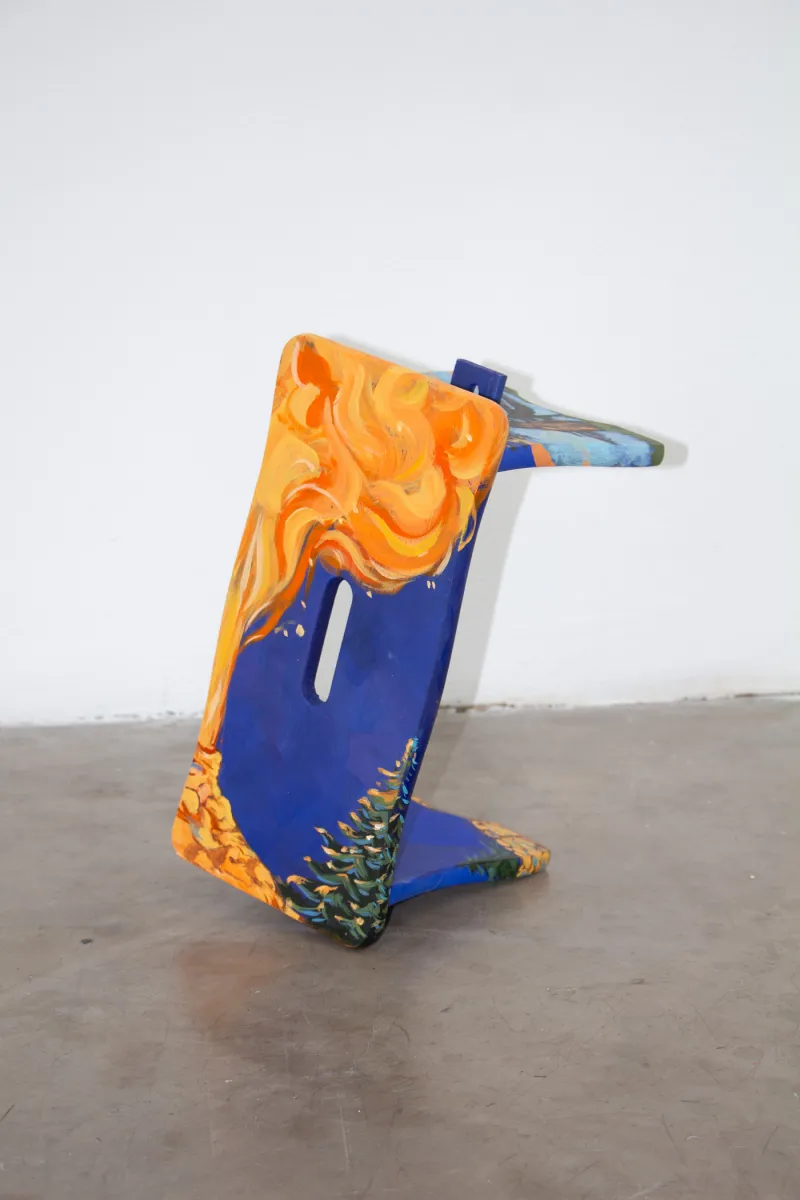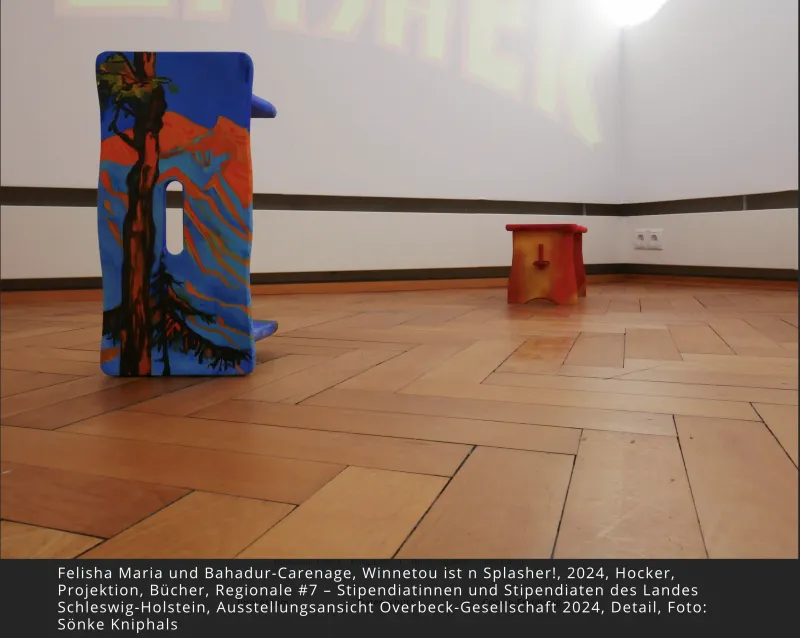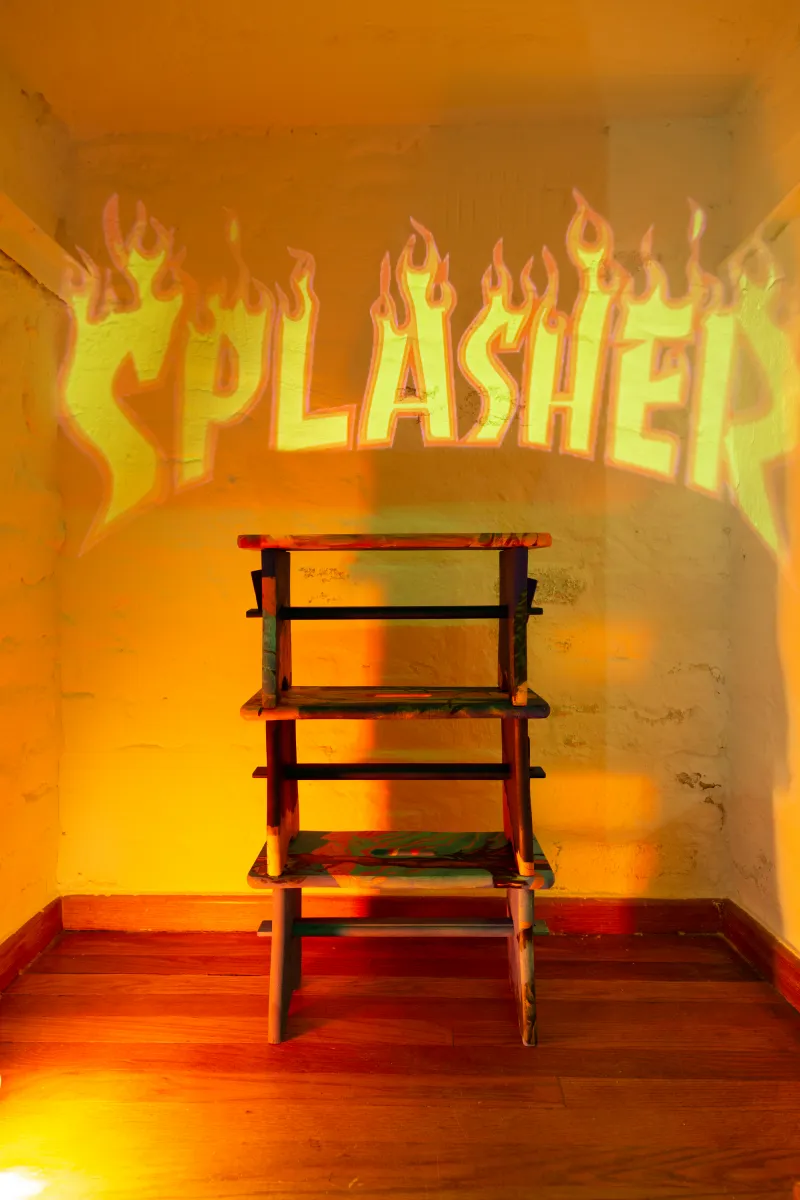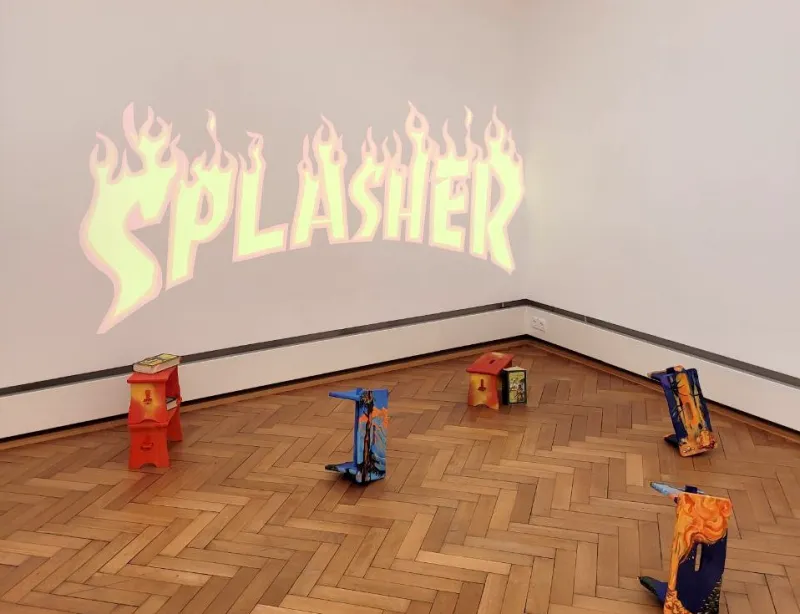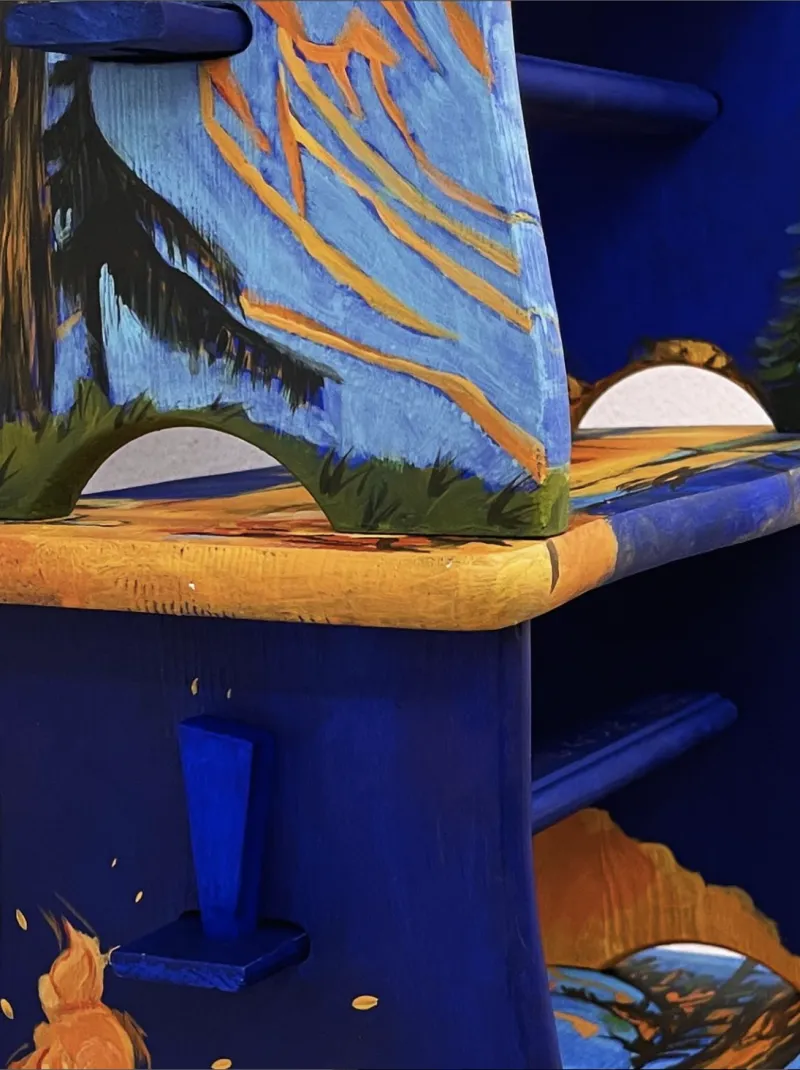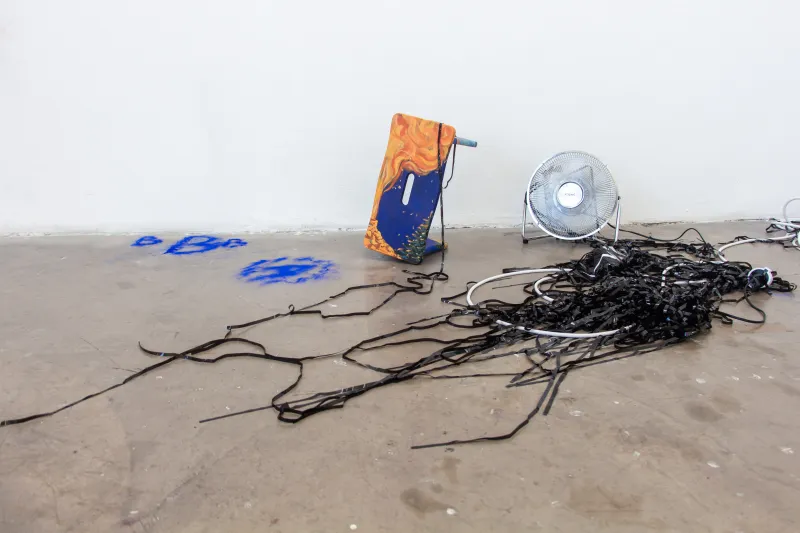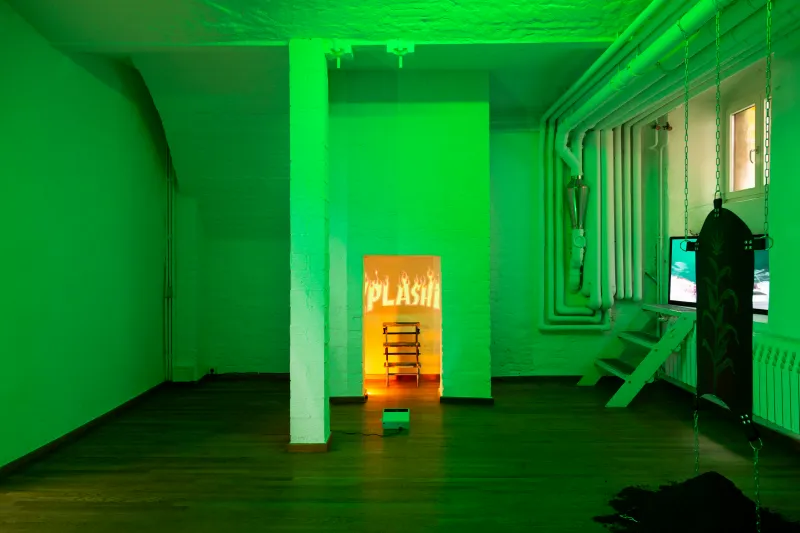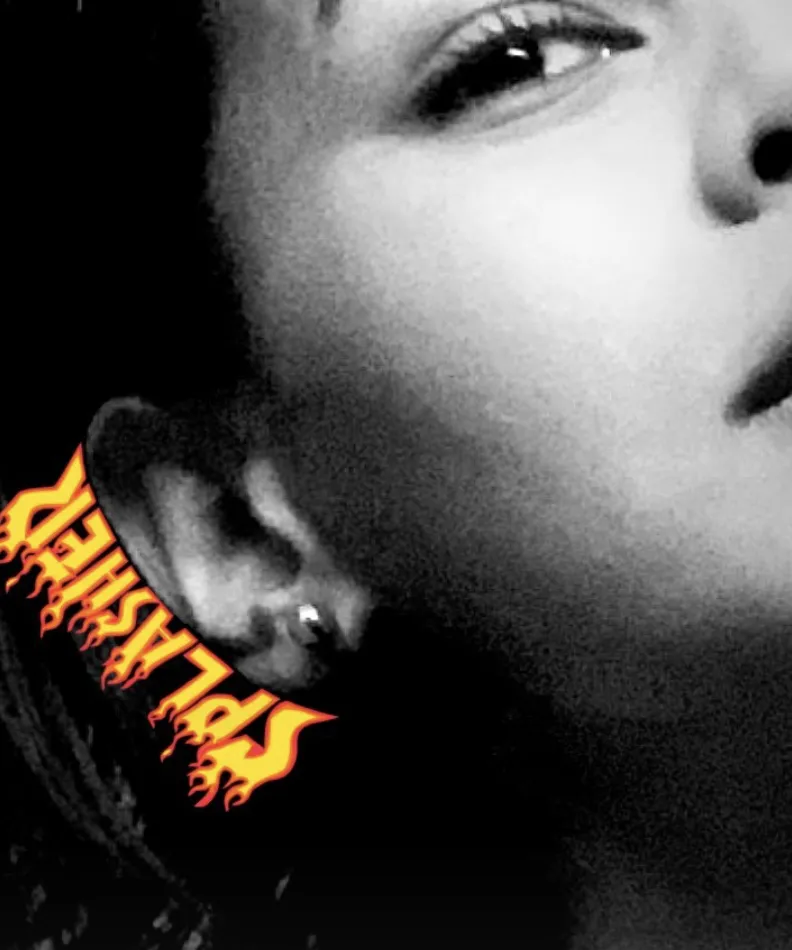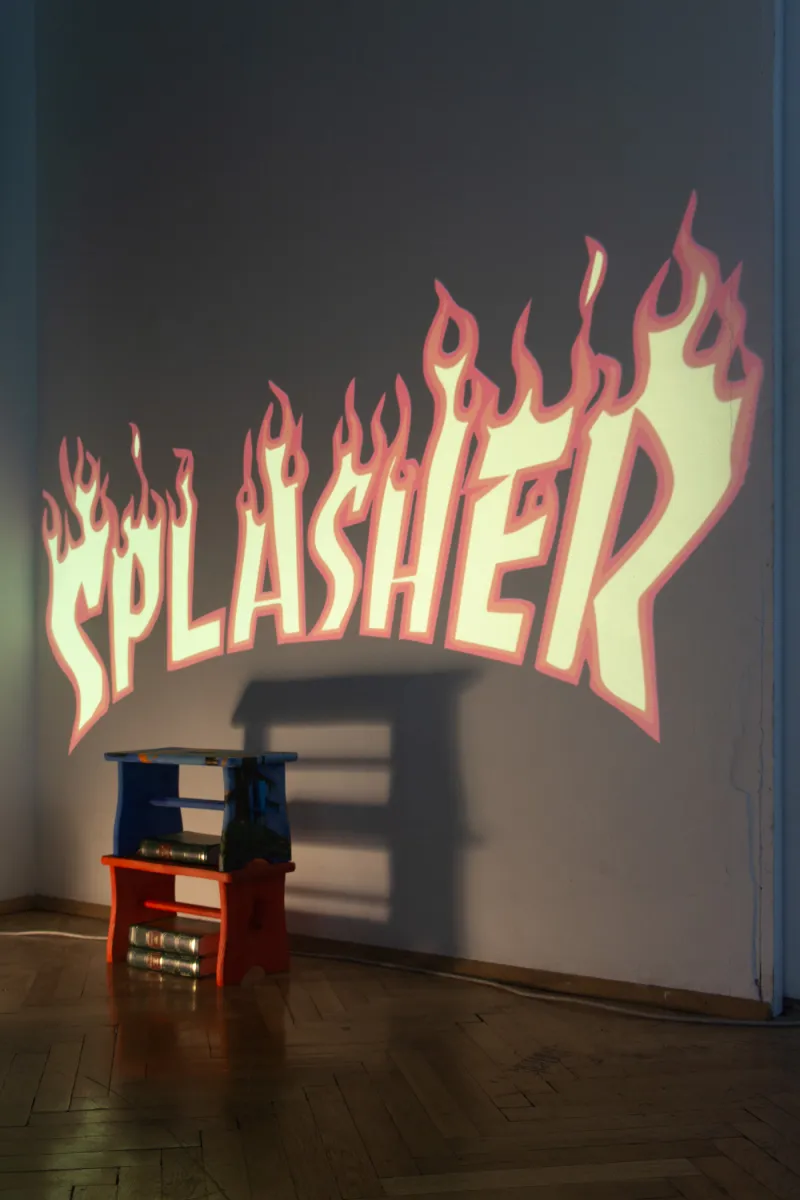🔥Winnetou ist n Splasher!🔥
DE: 🔥 Winnetou ist n Splasher!🔥 gehört zu der Colportage Serie von Arbeiten, die sich mit den Titelbildern von Pop-Fiction Büchern auseinandersetzen. Die Colportagen Malereien verwenden gewöhnliche Möbel anstelle von Leinwänden, um mit populären nationalen Codes der 'Domestizität' wie Zugehörigkeit, Heimat und Kultur zu spielen. Die 🔥Winnetou ist n Splasher!🔥 Hocker sind mit den Namen von deutschen Fabulierern wie Karl May, Jerry B. Anderson und Tilo Kruse beschriftet; die Aneignung ihrer Namen auf meinen Kunstwerken ist ein Versuch, ihre Mythen zu übernehmen. Die Objekte nehmen malerisch Bezug auf die Titelbilder der Karl-May-Romane, denn die Romantik dieser Landschaften durch die Auslöschung menschlichen Lebens aufrechterhalten wird. In dieser Arbeit betrachte ich mein eigenes Leben als Teil der Ausgelöschten.
EN: The 🔥Winnetou ist n Splasher!🔥 stools are labelled with the names of German storytellers such as Karl May, Jerry B. Anderson and Tilo Kruse; the appropriation of their names on my artworks is an attempt to take on their myths. The objects make painterly reference to the covers of the Karl May novels, as the romance of these landscapes is sustained by the extinction of human life. In this work, I consider my own life as one of those erased.
🔥 Winnetou ist n Splasher!🔥 is part of the Colportage series of works that explore the covers of pop fiction books. The Colportage paintings use ordinary furniture instead of canvases to play with popular national codes of 'domesticity' such as belonging, home and culture. These stools also reference the peera as used in Trinidad & Tobago, and which has appeared in artist Chris Cozier's work and writing.
Winnetou ist ein Splasher! is the title of a YouTube parody by a north german humourist known as ‚Jerry B. Anderson‘, which surfaced over a decade ago. The video is original, the sound dubbed. Actor Pierre Brice is in full redface as author Karl May’s famously pantywetting fictional Native American Indian Winnetou. Brice is with school-aged children, in some kind of television special.
In the universe of Anderson’s particular, vulgar german/English vernacular, the dubbed Winnetou addresses the children as Splashers, meaning ‘wankers’. In 2013 at the beginning of my Masters in Fine Art at the Muthesius University of Art and Design, my integration into the city and the art school included being shown this video by my then peers. I was elated to have been granted access to this code; to address others as 'Splasher!' was not only the height of hilarity, but a truly viable currency among the arbiters of local culture. My peers were surfing, skateboarding, hip-hop-loving, Fusion-festival-devotee white north germans in creole earrings, Thrasher tees and Nike Shox whose childhoods were shaped (indirectly or not) by the cowboy/ indian fantasy of live-action shows featuring Winnetou; one of the latest generations in a tradition dating back to 1951, when Germany was refurbishing its image.
This regional tradition of live action plays is called the Bad Segeberg Spiele, which performs only Karl May's Winnetou stories (May had also written about other spaces outside of Europe). Not only are these shows a continuation of colonial violence, but an insidious stronghold of aryan mythmaking. Some of their problematics include: a claim to generations of white actors in redface; the shows are held in a former National Socialist arena which was designed for 'folk entertainment'; the Karl May novels imbued Adolf Hitler's colonial revisionism with romance and wonder, etc.
Of the (myriad, yearly) cultural defences made for the Bad Segeberg Spiele, the most popular seems to be this: Winnetou is a myth for the entertainment of children. To criticise the content and context of Winnetou is to threaten and violate the wonder and innocence of white german childhood. That Anderson's parody video features Winnetou with a group of white school-aged children, and not a scene from a film or the stage where Winnetou is with other adult figures, riding a horse or wielding a gun, is the catalyst for this artwork.
Anderson, whose last work appears to have been a coolness sign-off on a white townie rapper, seems, with the Winnetou dubbing, to be acknowledging the untenability of White Innocence. This is paralleled now, ten years later, by progressive german families emptying their homes of Karl May books, beautiful editions of which were gifted by grandfathers (who had acquired generational wealth and status under the 3rd Reich) and can now be found in the garbage, in book-swaps, on eBay.
Winnetou is a purportedly blank space upon which Karl May projected his own heroism, sexuality and innocence, which is part of the figure's great appeal to a nation that was only de-nazified on paper. Because this parodied and revered Native American Indian („der scheiß Indianer,“ dubs Anderson) figured so much in my art-school-specific integration due to racialised desire and subjugation and – especially after BLM peaking in 2020 – the fake-woke part of blackfishing, as well as myself being a fictional Indian*, I have come to understand him as my Doppelgänger.
A fine art sublimation of the Thrasher magazine logo plays with contexts of cultural appropriation; this corporate logo is an aspect of my former peers' visual culture which is not an immediately obvious violation of ethnicised codes of dress and belonging, and is thus a tenable space for whiteness' protection of its privileges.
Using furniture in lieu of canvas, I play with popular national codes of domesticity like belonging, home, culture. The small stool has a clear West Indian context, long addressed by artist Chris Cozier. The 🔥Winnetou ist n Splasher!🔥 stools are inscribed with the names of german fabulators like May, Anderson, and Tilo Kruse; appropriating their names onto my artworks is an attempt to claim and thus destroy their myths.
The stools make painterly reference to the cover art of the Winnetou novels: the romance of these landscapes is sustained through the erasure of human life. This perspective on nature is what helps sustain contemporary forms of the aryan Lebensraum project, and which has compromised not only my education and practice as a painter, but my ability and autonomy to move through european space without threat of violence and death.
* I was born in the West Indies
Exhibited:
Santa Maria Paraffina: myth § trope § glitch, VBKÖ, Vienna, April-May 2025
Regionale VII, c. Sönke Kniphals, Overbeck Gesellschaft, Lübeck, September 2024
Regionale VII, c. Sönke Kniphals, Gallery Cube+, Kiel, October 2024
Inversion/Conversion, c. Will Fredo, BPA// Raum, June 2024
Related Events.
